In today’s interconnected global marketplace, businesses are recognizing the critical importance of an efficient and well-managed supply chain. From the initial production stages in the factory to the final delivery of products to customers, every step in the supply chain plays a crucial role in ensuring success and maintaining a competitive edge.
Throughout this article, we emphasize the need for a holistic supply chain perspective, where the factory serves as a focal point, but the integration and coordination of processes extend far beyond. By adopting this comprehensive outlook, businesses can overcome challenges, leverage opportunities, and establish a resilient and agile supply chain that drives growth and ensures long-term success in today’s dynamic business landscape.
One area to explore further is the use of technology in supply chain management. Advancements such as artificial intelligence (AI), big data analytics, and blockchain have revolutionized how businesses handle inventory control, demand forecasting, and supplier collaboration. Exploring these technological advancements can provide insights into how they are transforming the supply chain perspective, where the factory serves as a focal point but the integration and coordination of processes extend far beyond. By adopting this comprehensive outlook, businesses can overcome challenges, leverage opportunities, and establish a resilient and agile supply chain in manufacturing that drives growth and ensures long-term success in today’s dynamic business landscape.
Contents
The Three Primary Stages of Supply Chain Management
Supply chain management encompasses a series of interconnected processes that span the entire lifecycle of a product, beginning from its inception and extending to its distribution to end consumers. This holistic approach involves three primary stages, each playing a crucial role in the efficient functioning of the supply chain:
- ⇒ Manufacturing: This stage involves the production of the product in one or multiple factories.
- ⇒ Warehousing and Distribution: Once the products are manufactured, they are typically transported to a warehouse for storage and subsequent distribution. Warehouses serve as strategic hubs for inventory management, providing a centralized location for storing goods until they are ready to be dispatched.
- ⇒ Customer Delivery: After the products have been stored in the warehouse, they are transported and distributed directly to the end customers.
It should be noted that very often both the factory and the warehouse are subcontractors.
That means that the company showcases its unique approach to product sales by leveraging clear criteria and embracing outsourcing for production. This innovative strategy allows the company to effectively deliver high-quality products to its customers while optimizing resources by utilizing the production capacity of external factories.
Key Processes and Terms in Supply Chain Management
Factory
A factory is a manufacturing facility where goods are produced. Factories can be large or small, and they can produce a wide variety of products. The specific operations of a factory will vary depending on the type of goods being produced. However, there are some common steps involved in the manufacturing process, such as:
- Sourcing materials. The first step in the manufacturing process is to source the materials needed to produce the goods. This may involve purchasing raw materials from suppliers or using recycled materials.
- Manufacturing. Once the materials have been sourced, they are then used to manufacture the goods. This process may involve a variety of steps, such as cutting, assembling, and packaging.
- Quality control. Once the goods have been manufactured, they are then inspected to ensure that they meet quality standards. This may involve testing the goods for defects or ensuring that they meet the correct specifications.
- Packaging. Once the goods have been inspected, they are then packaged for shipping. The packaging may be designed to protect the goods during shipping or to make them easier to display and sell.
- Shipping. The final step of the supply chain manufacturing process is to ship the goods to the customer. This may involve using a variety of shipping methods, such as trucks, trains, or airplanes.
Key Functions of Headquarters in the Factory Stage
In the context of manufacturing, the headquarters is responsible for:
- ⇒ Coordinating the manufacturing process. This includes working with factories to ensure that they have the necessary materials and equipment to produce the goods.
- ⇒ Setting quality standards. The headquarters is responsible for setting the quality standards that all goods produced by the company must meet.
- ⇒ Managing inventory. The headquarters is responsible for managing the company’s inventory of raw materials, work-in-progress, and finished goods.
- ⇒ Planning for future production. The headquarters is responsible for planning for future production needs, such as forecasting demand and ordering raw materials.
Key Terms in the Factory Stage
Here are some of the terms that are commonly used in the manufacturing industry:
- ⇒ Purchase order (PO). A PO is a document that orders goods from a supplier. The PO specifies the quantity, quality, price, and delivery terms of the goods.
- ⇒ Interterminal transport (ITT). ITT is the process of transferring containers between two terminals. This can be done by truck, train, or ship.
- ⇒ Lead time = manufacturing time + shipping time Lead time refers to the total time it takes for a product to be manufactured and delivered to the customer. It is calculated by adding the manufacturing time and the shipping time together.
- – Manufacturing time: The duration to produce the product, including sourcing materials, manufacturing, quality control, and packaging.
- – Shipping time: The duration for product transportation from the manufacturing facility to the customer’s location, including transit time, shipping method, distance, and possible delays.
- ⇒ Part number (SKU), batch/lot
- – SKU is a unique identifier assigned to a specific product or item in a company’s inventory. The SKU is used for internal tracking and management purposes, allowing businesses to identify and differentiate between different products or variations of products.
- – Batch/lot – a group of products manufactured together or produced under similar conditions, often identified by a specific batch or lot number. It allows for traceability and quality control, as products within the same batch/lot are assumed to have similar characteristics or properties. This information is useful in case of recalls, quality issues, or tracking the history of a product.
- ⇒ Raw materials vs. finished goods
- – Raw materials: These are the basic materials or substances that are used in the production of goods.
- – Finished goods: These are the end products that have completed the production process and are ready for sale or distribution to customers.
The distinction between raw materials and finished goods is essential in supply chain management manufacturing, inventory control, and production planning.
- ⇒ Incoterms. A set of standardized rules that provide clarity and uniformity in international trade by defining specific terms related to the delivery of goods, transfer of risks, and allocation of costs between the parties involved. Incoterms are used by businesses all over the world to ensure that there is a clear understanding of the terms of a sale or purchase agreement. For example, the Incoterm EXW (Ex Works) means that the seller is responsible for delivering the goods to the buyer’s premises, but the buyer is responsible for loading the goods onto the buyer’s transport. The Incoterm DDP (Delivered Duty Paid) means that the seller is responsible for delivering the goods to the buyer’s premises and paying all of the import duties and taxes.
The Role of Different Teams in Supply Chain Management
- ⇒ Procurement department
- ⇒ Transportation department
- ⇒ QA department
- ⇒ Accounting department
Procurement department: The procurement department is responsible for sourcing and acquiring goods, services, and raw materials needed for the organization. They handle supplier selection, negotiation of contracts, purchasing, and maintaining supplier relationships.
Transportation department: The transportation department manages the movement of goods and materials within the organization’s supply chain. They coordinate logistics, select carriers or shipping methods, optimize routes, track shipments, and ensure timely and efficient delivery.
QA department (Quality Assurance): The QA department focuses on maintaining and ensuring the quality of products or services. They establish quality standards, perform inspections and tests, monitor production processes, identify defects or non-compliance, and implement corrective actions to maintain high-quality standards.
Accounting department: The accounting department is responsible for managing financial transactions, tracking expenses, and ensuring accurate financial records. They handle budgeting, financial reporting, accounts payable and receivable, payroll, tax compliance, and financial analysis.
These departments work collaboratively to support the overall operations and success of the organization. They each have their specific areas of expertise and contribute to different aspects of the business, such as procurement, transportation, quality control, and financial management.
Warehouse
A warehouse is a facility that stores and ships goods. Warehouses can be large or small, and they can be used to store a wide variety of goods. The specific operations of a warehouse will vary depending on the type of goods being stored and shipped. However, there are some common tasks that are performed in all warehouses, such as:
- ⇒ Receiving goods: Warehouses receive goods from suppliers, manufacturers, or other businesses. This process involves inspecting the goods for damage, verifying the quantity and quality of the goods, and recording the receipt of the goods in the warehouse’s inventory system.
- ⇒ Storing goods: Once goods have been received, they need to be stored in a safe and organized manner. Warehouses use a variety of methods to store goods, such as racking, shelving, and bins. The specific storage method used will depend on the type of goods being stored and the available space in the warehouse.
- ⇒ Shipping goods: When goods are ready to be shipped to customers, they are picked from the warehouse and loaded onto trucks, trains, or airplanes. The shipping process involves preparing the goods for shipment, such as packing them and labeling them, and arranging for transportation.
- ⇒ Inventory management: Warehouses need to keep track of the goods that they have in stock. This is done through an inventory management system, which tracks the quantity, location, and status of all goods in the warehouse. Inventory management is important for ensuring that the warehouse has the right goods in the right quantity at the right time.
Key Functions of Headquarters in the Warehouse Stage
In the context of warehouse operations, the headquarters is responsible for:
- ⇒ Providing order data: The headquarters provides the warehouse with order data, which includes the order number, customer information, and product information. This data is used by the warehouse to pick and ship orders.
- ⇒ Arranging shipping: The headquarters may arrange for shipping from the warehouse to other countries’ warehouses. This is typically done for large or urgent orders.
- ⇒ Requesting inventory counts: The headquarters may request inventory counts from the warehouse. This is done to ensure that the warehouse has the correct quantity of goods in stock.
- ⇒ Managing last-mile delivery carriers’ contracts: The headquarters may manage contracts with last-mile delivery carriers. This is done to ensure that the warehouse has a reliable and cost-effective way to ship goods to customers.
Key Terms in the Warehouse Stage
- ⇒ Optimal quantity
- – Optimal Quantity: Optimal quantity refers to the ideal amount of inventory or goods to be ordered or produced to meet demand while minimizing costs. It involves finding the balance between carrying enough inventory to fulfill customer orders and avoiding excessive carrying costs associated with overstocking.
- ⇒ Bin
- – A bin is a designated storage location within a warehouse or inventory system where products or materials are stored. Bins are typically labeled or identified with specific codes or numbers to facilitate accurate tracking and efficient retrieval of items.
- ⇒ Packing station
- – A packing station is an area within a warehouse where products are prepared for shipment. It typically includes tools, equipment, and packaging materials necessary for packing goods securely and efficiently, such as boxes, tapes, labels, and cushioning materials.
- ⇒ Inventory, EOM count, ABC count
- – Inventory refers to the total stock of goods or materials held by a business at a specific point in time. EOM (End of Month) count refers to the inventory count conducted at the end of each month to determine the quantity of products on hand. ABC count is a method of categorizing inventory based on its value or importance, with A representing high-value items, B representing medium-value items, and C representing low-value items.
- ⇒ DIM (dimentional) weight
- – DIM weight is a calculated weight used in shipping to account for the space occupied by a package based on its dimensions. It is used by carriers to determine shipping costs when the package’s dimensional weight is higher than its actual weight.
- ⇒ FEFO (First Expire, First Out), FIFO (First In, First Out), LIFO (Last In, First Out)
- – FEFO (First Expire, First Out), FIFO (First In, First Out), LIFO (Last In, First Out): These are different methods of inventory management and stock rotation. FEFO refers to prioritizing the use or sale of products based on their expiration dates, ensuring that the oldest items are used or sold first. FIFO follows the principle of using or selling the oldest items in inventory first, while LIFO uses or sells the most recently acquired or produced items first.
- ⇒ Stock warehouse
- – A stock warehouse is a storage facility or area specifically designed for holding and organizing inventory or stock. It is typically managed by a business to store finished goods, raw materials, or components until they are needed for production or shipment.
- – A stock warehouse is a storage facility or area specifically designed for holding and organizing inventory or stock. It is typically managed by a business to store finished goods, raw materials, or components until they are needed for production or shipment.
Teams Roles in the Warehouse Stage
- ⇒ Logistics department
- ⇒ Order analysis department
- ⇒ Inventory department
Logistics department: The logistics department is responsible for managing the movement of goods and materials throughout the supply chain. They handle tasks such as transportation, warehousing, inventory management, order fulfillment, and distribution. The logistics department ensures the efficient flow of products from the point of origin to the point of consumption while optimizing costs and meeting customer requirements.
Order analysis department: The order analysis department focuses on analyzing customer orders and identifying patterns, trends, and insights to improve order processing and fulfillment. They analyze order data, assess order accuracy, monitor order fulfillment timelines, and identify areas for improvement in order management processes. The department may also work closely with other teams, such as sales, customer service, and inventory management, to optimize order processing and enhance customer satisfaction.
Inventory department: The inventory department is responsible for managing and controlling the organization’s inventory levels. They monitor inventory levels, track stock movements, conduct regular stock counts, and reconcile discrepancies. The inventory department works closely with procurement and production teams to ensure optimal stock levels, prevent stockouts or overstocking, and maintain accurate inventory records. They also play a vital role in inventory forecasting, demand planning, and implementing inventory management systems or technologies.
These departments work together to ensure the smooth operation of the supply chain. The logistics department manages the physical flow of goods, the order analysis department focuses on improving order processing efficiency, and the inventory department oversees inventory control and optimization. Collaboration among these departments is essential for effective supply chain management, meeting customer demands, and achieving operational excellence.
IT Tools in the Warehouse Stage
- ⇒ WMS (Warehouse Management System)
- ⇒ EDI (Electronic data interchange)
- ⇒ Packer software (Camera, Scale, Scanner, Printer)
- ⇒ Scanning apps (works on handheld scanner devices)
- ⇒ MRP/Forecasting tools (Material Resource Planning)
- ⇒ Order pick-up apps
WMS (Warehouse Management System): Software that manages and optimizes warehouse operations, including inventory management, order fulfillment, and shipping.
EDI (Electronic Data Interchange): System for electronic exchange of business documents between trading partners, enabling automated and standardized communication.
Packer software (Camera, Scale, Scanner, Printer): Software integrated with hardware devices to assist in packing operations, including visual inspection, weighing, barcode scanning, and label printing.
Scanning apps (works on handheld scanner devices): Software applications for handheld scanners that enable barcode or QR code scanning for inventory management, order picking, and receiving.
MRP/Forecasting tools (Material Resource Planning): Software applications that analyze demand forecasts, inventory levels, and production schedules to optimize materials and resources required for production.
Order pick-up apps: Software applications that provide order details, picking instructions, and navigation guidance to pickers for accurate and efficient order fulfillment.
The Last Step in the Supply Chain: The Customer
In the intricate network of the supply chain, the ultimate objective is to deliver products and services to the customer. The customer represents the final destination and the driving force behind all supply chain efforts. To ensure a successful and satisfying customer experience, businesses must focus on several key aspects when serving the customer.
Key Functions of Headquarters in the Customer Stage
- ⇒ Address Validation: One of the primary responsibilities of the headquarters is to validate customer addresses. This step ensures that the products are shipped to the correct destination, minimizing delivery errors and customer dissatisfaction.
- ⇒ Order Status Updates: The headquarters serves as a reliable source for customers to obtain real-time updates on their orders. It provides multiple channels for order status notifications, including email, website notifications, and mobile app alerts. This proactive communication keeps customers informed about the progress of their orders and reduces inquiries, improving customer satisfaction.
- ⇒ Comprehensive Order Tracking: The headquarters tracks all orders, whether from customers or non-customers, to ensure end-to-end visibility and control. By monitoring order statuses, the headquarters can identify potential bottlenecks or delays in the supply chain and take corrective actions promptly. This proactive approach helps maintain order accuracy and timely delivery.
- ⇒ Revenue Recognition: The headquarters defines criteria for closing an order to accurately count revenue. By establishing clear guidelines, the company can track and report revenue effectively. This enables better financial planning, forecasting, and analysis.
Customer Interactions
- ⇒ Order Placement: Customers provide essential details to the headquarters, including their shipping address, desired product quantities, and payment information. This information is crucial for processing orders accurately and efficiently.
- ⇒ Delivery Signatures: Headquarters ensures that delivery signatures are obtained when products are received by customers. This helps verify that the products were successfully delivered and provides proof of receipt, offering both the customer and the company a level of assurance.
- ⇒ Product Returns: In case customers need to return a product, the headquarters manages the return process. It handles customer inquiries, authorizes returns when appropriate, and coordinates the logistics involved in receiving and processing returned items. By efficiently managing returns, the headquarters enhances customer satisfaction and supports a positive post-purchase experience.
Key Processes and Terms in the Customer Stage
- ⇒ Order vs Shipment
- – An order refers to a customer’s request to purchase goods or services. It is the initial request made by a customer to a business. A shipment, on the other hand, refers to the physical act of delivering the ordered goods to the customer. It involves packaging, labeling, and transporting the products from the seller’s location to the buyer’s location.
- ⇒ Commercial invoice/Invoice/Packing slip
- – A commercial invoice is a document provided by the seller to the buyer that details the products or services sold, their quantities, prices, and other relevant information for customs and financial purposes. An invoice is a document that provides a detailed summary of the goods or services provided, their prices, payment terms, and other necessary information. A packing slip, also known as a delivery note, is a document that accompanies a shipment and lists the items contained in the package.
- ⇒ Signature required/Indirect signature
- – Signature required is a shipping service option that requires the recipient to sign for the delivery of a package. This ensures proof of delivery and adds an extra layer of security. Indirect signature is a similar service option, but it allows someone other than the recipient, such as a neighbor or doorman, to sign for the package on the recipient’s behalf.
- ⇒ RMA (Return merchandise authorization)
- – RMA, or Return Merchandise Authorization, is a process used to authorize and track product returns from customers. It involves obtaining permission from the seller to return a product, typically due to defects, damage, or other issues. The RMA process helps streamline returns, ensures proper handling of returned items, and enables the tracking of returned goods from the customer back to the seller for repair, replacement, or refund.
The Role of Different Teams in the Customer Stage
- ⇒ Customer Service department
- – The Customer Service department is responsible for assisting customers with inquiries, concerns, and providing support before, during, and after the purchase of products or services. They handle customer communication, resolve issues, process orders, and strive to ensure a positive customer experience.
- ⇒ Warehouse staff
- – Warehouse staff members are responsible for various tasks within the warehouse, including receiving and inspecting incoming shipments, organizing and storing inventory, picking and packing orders, conducting inventory counts, and preparing shipments for delivery. They play a crucial role in maintaining the smooth operation of warehouse activities.
- ⇒ Accounting department
- – The Accounting department is responsible for managing financial transactions, recording and analyzing financial data, preparing financial statements, and ensuring accurate financial records. They handle tasks such as accounts payable and receivable, payroll, tax compliance, budgeting, and financial reporting. The Accounting department helps maintain the financial health and transparency of the organization.
IT Tools for Customer Support and Communication
- ⇒ Website
- ⇒ App
- ⇒ Internal tools for customer support
The Role of Blockchain in Supply Chain Management
Blockchain technology in the supply chain refers to the use of a distributed and decentralized ledger system to record and track transactions and data related to the movement of goods and services within the supply chain. Here are some key aspects of blockchain in the supply chain:
- Transparency and Traceability: Blockchain provides a transparent and immutable record of transactions, allowing all participants in the supply chain to have real-time visibility into the movement and history of products. It enables tracing the origin, location, and authenticity of goods, helping to prevent counterfeiting, fraud, and unauthorized modifications.
- Smart Contracts: Smart contracts are self-executing agreements coded on the blockchain that automatically execute predefined actions when specific conditions are met. In the supply chain, smart contracts can automate processes such as payment settlements, delivery verifications, and contract compliance, reducing the need for intermediaries and streamlining operations.
- Enhanced Security: Blockchain’s decentralized nature and cryptographic algorithms provide a high level of security for supply chain data. Transactions recorded on the blockchain are resistant to tampering and hacking, ensuring the integrity and confidentiality of sensitive information.
- Efficiency and Cost Savings: Blockchain can improve supply chain efficiency by reducing paperwork, manual processes, and the need for intermediaries. It enables real-time sharing of trusted information among supply chain participants, leading to faster decision-making, streamlined workflows, and reduced administrative costs.
- Supply Chain Collaboration: Blockchain facilitates secure and trusted collaboration among different stakeholders in the supply chain, including suppliers, manufacturers, distributors, retailers, and customers. It enables the sharing of data, documents, and certifications in a decentralized manner, fostering better communication, coordination, and trust among participants.
By leveraging blockchain technology in the supply chain, organizations can achieve greater transparency, efficiency, and trust, resulting in improved accountability, reduced fraud, optimized inventory management, and enhanced overall supply chain performance.
Our Expertise in Supply Chain Software Solutions
As a digital solutions provider, we excel in developing software for warehouse management, transportation management, and various other supply chain activities. Our team of experienced engineers has extensive knowledge in creating order-tracking management systems, optimizing shipping costs and methods on a global scale, integrating carrier APIs, and more. We are committed to delivering innovative and reliable software solutions to streamline and enhance your logistics and supply chain operations. Contact us to learn more about how our manufacturing supply chain software solutions can help your business thrive in today’s global marketplace. Our comprehensive approach to supply chain management, coupled with cutting-edge technology, will empower your business to overcome challenges, seize opportunities, and achieve long-term success in the dynamic and competitive business landscape. Let us help you build a resilient and agile supply chain that drives growth and exceeds customer expectations.
Contact us now to explore how our expertise can transform your supply chain and take your business to new heights.
FAQ:
What are the key functions of the logistics department in the warehouse stage?
The logistics department in the warehouse stage is responsible for managing the movement of goods and materials, coordinating transportation, optimizing routes, tracking shipments, and ensuring timely and efficient delivery.
How does the customer service department contribute to the customer stage of the supply chain?
The customer service department assists customers with inquiries, provides support before, during, and after purchases, and ensures a positive customer experience by resolving issues and processing orders.
What is the role of headquarters in supply chain management?
The headquarters of an organization plays a vital role in supply chain management, including coordinating manufacturing processes, setting quality standards, managing inventory, and planning for future production needs.
How can technology advancements like AI, big data analytics, and blockchain revolutionize supply chain management?
Technology advancements such as AI, big data analytics, and blockchain have transformed supply chain management by providing real-time data insights, optimizing inventory control, improving demand forecasting, enhancing supplier collaboration, and ensuring traceability and transparency across the supply chain.








